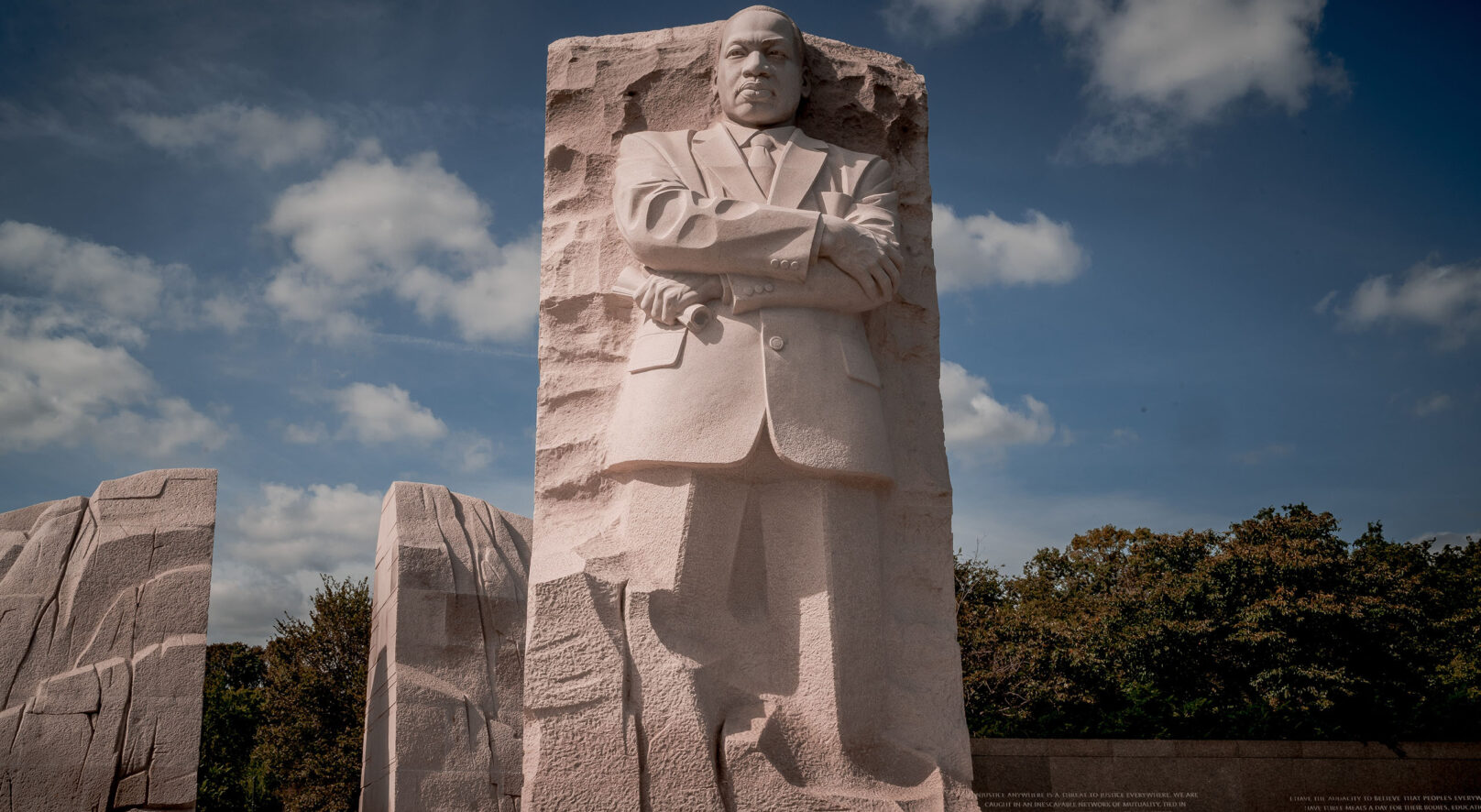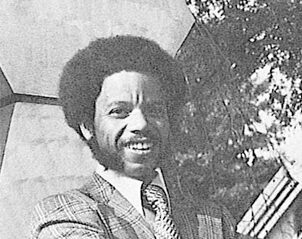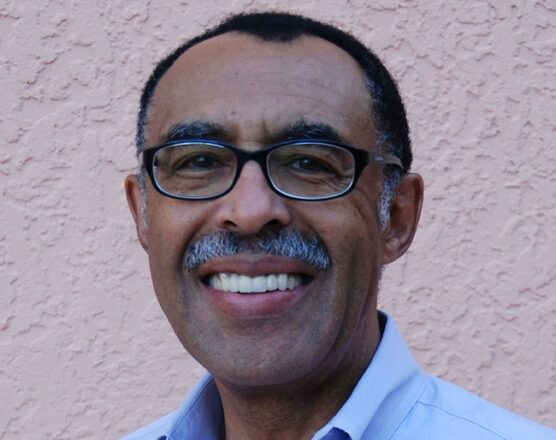The Architecture of Citizenship
February 24, 2023
Share

The Martin Luther King Jr. National Memorial in Washington, DC, sits just off the National Mall. Sited along the Path of Leadership—between memorials to Presidents Lincoln, Roosevelt, and Jefferson—the 30-foot-tall luminous granite relief looks toward the horizon over the Potomac Tidal Basin.
Once in the park, many visitors stop to take photos. But, due to the size of the statue, a selfie with Dr. King is difficult to accomplish. So instead, people from all over the world turn to one another and ask for help. They hand over their expensive phone or camera and watch as the stranger backs up 20 or 30 feet to capture both the subject and the statue. They trust this person to take the picture and return the technology. Then they come together, look at the picture, and say thank you.
“Being the size that it is was intentional,” says C&S Fellow James Chaffers, a recipient of a 1969 MLK Fellowship and a senior design consultant for the King Memorial.
“It had to be something beyond a monument.”
The space the memorial creates fosters these intentional interactions. Exploring relationships between spatial design and human spirituality has been a guiding force in Dr. Chaffer’s design practice, teaching, and research.
 Dr. Chaffers first began wrestling with these relationships as a graduate student of Architecture. After a stint in the Army during the Vietnam War, Dr. Chaffers attended the University of Michigan on an MLK Fellowship from Citizens & Scholars (then the Woodrow Wilson National Fellowship Foundation). The Fellowship provided financial support for Black veterans to pursue graduate studies in preparation for careers in the service of society.
Dr. Chaffers first began wrestling with these relationships as a graduate student of Architecture. After a stint in the Army during the Vietnam War, Dr. Chaffers attended the University of Michigan on an MLK Fellowship from Citizens & Scholars (then the Woodrow Wilson National Fellowship Foundation). The Fellowship provided financial support for Black veterans to pursue graduate studies in preparation for careers in the service of society.
Once in his graduate program, he was able to think more deliberately about what architecture meant. “I sensed that architecture was more than building buildings,” he says. “If we didn’t give as much attention to what our intentions were for a building, or what we were trying to cultivate, then it would just be a building. It would just be a thing. Our underlying intentions guided me.”
The MLK Fellowship gave Dr. Chaffers both the financial support and the confidence that he was pursuing a worthwhile question: “It gave more support to the idea that I didn’t want to be a conventional architect. I saw the Fellowship as an obligation, not as a burden but as an opportunity, to do my best even better. That was particularly nourishing.” Graduating in 1971, he was awarded the first Professional Doctorate of Architecture degree in the nation, from the University of Michigan’s Taubman College of Architecture and Urban planning.
The MLK Fellowship: 55 Years of LeadershipEventually, Dr. Chaffers was invited to join the University of Michigan faculty, where he has had a dedicated and illustrative career as a scholar, teacher, and mentor. During his time at Michigan, Dr. Chaffers served as director of Taubman College’s Ph.D. program in architecture, director of the Florence-Tuscany Design Studio in Florence, Italy, and founder-director of the West African Design Studio in Kumasi, Ghana. He holds three distinguished faculty and three outstanding teacher awards from Michigan and other universities, in addition to numerous other national and international honors for his teaching. Elevated to ‘Fellow’ in the American Institute of Architects, Dr. Chaffers has also received numerous professional honors.
In 1992 he taught a course, “Urban Redevelopment and Social Justice: Can We Have Both?” For Dr. Jenna Saul, the class made a lasting impact. “I’ll be 52 years old in a few weeks, I can say that Professor Chaffers put me on a path that helped me change lives in wonderful ways I hadn’t planned on,” she wrote in an email to the University of Michigan. “I stopped talking about the ‘they’ who act. I learned to listen. I learned to be responsible. I learned to explore information for myself… I have continued to pursue social justice and to educate myself in matters that impede it.”
Honoring An Architect That Made History
The University of Michigan cited his courses as leaving “a legacy of commitment and imagination to scores of students who then went out into the world and applied what they had learned there.”
Outside the classroom, Dr. Chaffers practiced the question of space and spirit and their mutual impact on communities through his two inner-city neighborhood design centers. Over the course of 27 years, Dr. Chaffer’s centers brought community members together to envision new possibilities for existing spaces within their neighborhoods.
“We had these meetings where folks are mixed and the races are mixed,” says Dr. Chaffers. “The ethnicities are mixed. The incomes are mixed. Ambitions are mixed. Because of this, it becomes a grander opportunity to stir the pot a different way.”
In Detroit, the GROW collaborative decided to focus on the large alleyways existing behind and between major neighborhood streets. These 18-foot-wide allies had become dangerous dumping grounds over the years. But to make any alterations—whether it be general cleanup and repairs, ideas for easier handicap access, or any other improvements—100% of neighborhood buy-in was legally required.
“So, in the instance of the GROW Neighborhood Association and its 300 or so families residing on the near west side of Detroit’s inner city, there was need for individual commitment to acts of collective trust and common caring,” says Dr. Chaffers
Related:C&S Fellows Organize Community Event in Chicago
In the end, 100% buy-ins were secured—making way for long, unbroken blocks to be cleared and re-purposed as neighborhood gathering places, shaded by trees from facing backyards.
These acts of collective trust and common caring—of “many hands making a city”—were made possible through the community’s commitment to mutual explorations of space and spirit. Such neighbor-with-neighbor collaborations sit at the core of Dr. Chaffers’ conception of citizenship:
citizenship 1. starts with self . . . at the center of an individual commitment to self-discovery; a commitment where each of us is further centered within overlapping circles of sharing, caring, trusting, relationships; a ‘spatial-spiritual’ overlapping wherein you/i feel completely safe and valued. 2. our relational ties as citizens — binding, bonding, ties where personal fulfillment is rooted in the idea of ‘public family’; specifically, the idea of working with other individual citizens to build relationships of trust and empowerment; relationships wherein ‘no one’ is left behind.
This definition of citizenship has arisen out of Dr. Chaffers’ current writings. After a career considering space and spirit and their interactions, he has become more convinced that this matrix of action is one word, SpaceSpirit, and that the two elements are inextricably linked.
This new book project will tap design language to help individuals navigate the intentionality they bring to their lives with others. “I’m seeking deeper definitions in common everyday words that will help us communicate our spatial and spiritual intentions within a democracy,” says Dr. Chaffers. “This notion of citizenship is hardly discussed. What I’m trying to build is an architecture of citizenship.”
He is finding that if we are to shape the next generation of futures, there are three fundamental requirements embedded within his definition of citizenship and all it entails: love, faith, and trust.
“Citizenship—firmly rooted in our own faith in self—has to have faith in the future,” notes Dr. Chaffers. “The word faith, as with love, is not about saying, or talking; nor is it tied to being a Muslim or Christian; rather, love and faith are commitments of ‘doing’—of putting our beliefs, our spiritual wills, into action.”
“Path-making, path-breaking citizenship trusts that there is a future, and that it is ours to shape.”

Today: Preparing the Next Generation for Civic Leadership
The Winter 2023 Civics Spring Fellows are young people tackling local community need by designing and executing projects across the country.
New Class of Gen-Zers Named as Civic Spring FellowsStay Engaged
Get More News
Join our mailing list to get more news like this to your mailbox.
Support Our Work
Help us invest in the talent, ideas, and networks that will develop young people as effective, lifelong citizens.
Ways to Support Us

